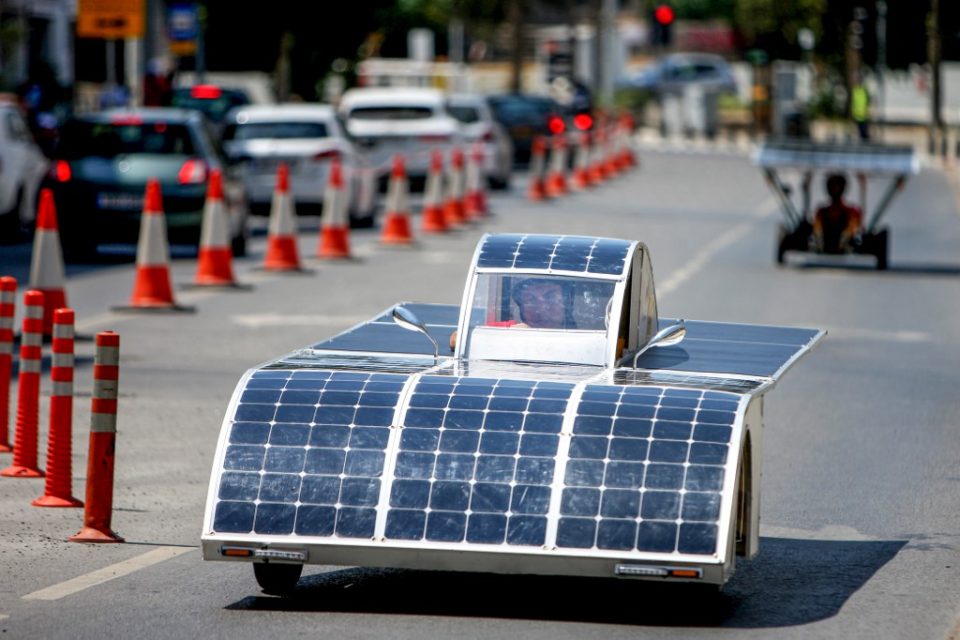
by Isabelle WESSELINGH and Emily IRVING-SWIFT
NICOSIA, Cyprus (AFP) — Venetia Chrysostomide fastened her helmet and rolled her solar-powered car into the sunny streets of Cypriot capital Nicosia for a race to showcase such vehicles’ eco-friendly potential, even on a budget.
The 16-year-old’s 5,000-euro (nearly $5,700) car is one of that took part in Sunday’s three-hour “Cyprus Institute Solar Car Challenge”, running solely on the Mediterranean island’s most plentiful resource: sunshine.
Many of the drivers were highschool students, including Chrysostomide, a maths and physics enthusiast from the nearby village of Dali.
“I am the only girl that will drive here in the race and I am very proud,” she said.
“With solar cars we take energy from the sun, so we can use this to reduce fuel consumption and air pollution.”
Her car was made up of parts from two mountain bikes, a metal frame and four solar panels, connected to batteries.
Tassos Falas, a teacher at her school, spent weeks working in his garage with colleague Anthoulis Hadjitali and mechanic Simos Markitanis to put together the car, capable of hitting 80 kilometres (50 miles) per hour.
Race organiser Aristides Bonanos, from the Cyprus Institute research centre, said participants had spent an average of just 8,000 euros on their vehicles.
That is in contrast to the hundreds of thousands spent on vehicles in the world’s biggest solar races — Australia’s gruelling 3,000 kilometre (1,800 mile) World Solar Challenge.
“When we first started the race we had the idea that there should be something where everyone can participate, so we limited the cost of our vehicles to 20,000 euros,” Bonanos said.
The goal is “to make the broader public more aware (that building a solar car is) something that is fairly easy and fairly cheap to do.”
That is an ambitious goal in a country with one of the highest rates of vehicle ownership in Europe, according to Eurostat: 595 cars per 1,000 residents.
In 2016, out of 28,000 new passenger cars registered on the island, just 22 were run on alternative energy sources.
– Suited for island life –
Yet solar-powered vehicles could be particularly suited to places like the Mediterranean holiday hotspot.
“Cyprus is a small island, maximum distances are about 150 to 200 kilometres”, well within the ranges of the cars competing in the Nicosia race, Bonanos said.
Similar reasoning has encouraged other islands to promote solar-powered transportation.
The French island of Belle-Ile-en-Mer, on the Bay of Biscay, is set to launch a car-sharing service later this year, with vehicles powered by excess energy from solar panels on the roofs of public buildings.
A similar project is being set up on the Portugese island of Porto Santo.
In Cyprus, which experiences some 320 sunny days per year, the potential is enormous.
But Falas warned that using hybrid or pure plug-in electric cars would not help the planet, as most electricity in Cyprus is generated by diesel and other fossil fuels.
“It would be beneficial only if you get your electricity out of the sun — and we have plenty of it,” he said.
In the end, an accident prevented Falas’s vehicle from finishing the race. The winner was the Hyperion 3, developed by Avgorou Technical School in the southeast of the island.
But Falas dreams that one day his car could become an everyday part of his life.
“I would love to be allowed to go to work with my car,” he said.
“I would park it in the sun in the parking lot of the high school, it will be fully charged by the end of the day and I would go back home, go and do some shopping without spending any money on fuel.”
© Agence France-Presse







